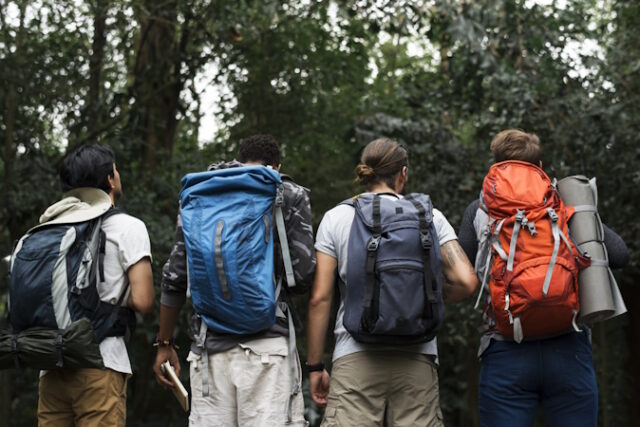
Hiking and trekking: two activities often need clarification as one. Peter Klein explores their differences in this article. Are you curious which one is for you? Read on and uncover the secrets of these thrilling pastimes!
Hiking is like a fun walk in nature’s park. It usually lasts a few hours or a day. You get to admire the picturesque surroundings and become one with nature. Trekking, however, takes it up a notch. This entails longer and more demanding journeys spanning days or weeks. Trekkers need physical and mental strength to conquer the rugged terrain and unpredictable weather.
Understanding Hiking
To understand hiking and make the right choice for adventure, immerse yourself in the section about understanding this. Discover the definition and purpose, explore its numerous benefits, and learn about popular trails and destinations. See how it can elevate the outdoor experience and connect you with nature.
Definition and Purpose of Hiking
This adventurous, invigorating activity involves marching through natural landscapes like mountains, forests, and trails. People hike for different reasons – some to challenge their bodies, others to reconnect with nature.
This activity tests the physical boundaries but also gives you a chance to escape the hustle of everyday life. The rhythm of walking helps clear your mind, and in nature’s serenity, you can find peace.
Benefits of Hiking
Hiking, a recreational activity involving walking in nature, offers many benefits.
- Fitness: It’s great for building your heart and lungs. Plus, you’ll burn calories and gain muscle tone.
- Mental health: Get out in nature to reduce stress, improve mood and raise self-esteem.
- Nature appreciation: Enjoy the beauty of nature while feeling peaceful and tranquil.
Unravel the secrets of history! Visit The Inca Trail in Peru and witness ancient ruins and beautiful landscapes. Or try the Appalachian Trail in the US, with its 2,000-mile-long journey through 14 states.
Understanding Trekking
To understand trekking, explore its benefits, and get acquainted with popular marching routes and expeditions. This section equips you with knowledge about the different aspects of trekking, allowing you to make informed decisions and choose the adventure that suits you best.
Definition of Trekking
Trekking is an adventure activity that involves traveling on foot. People explore nature and challenge their physical and mental strength. They also get a sense of freedom and isolation.
One must carry supplies like food, water, clothing, and equipment for marching. They will navigate through different landscapes with diverse flora and fauna. Trekking routes vary in both difficulty and duration.
Benefits of Trekking
Adventure-seekers adore marching – it has lots of advantages!
- It’s a way to escape the stress of daily life – a great way to relax and find inner peace.
- It helps you stay fit, walking and climbing over tough terrain. Plus, you get to see amazing scenery and be close to nature.
For the best experience:
Visit places like the Himalayas or the Appalachian Trail.
Take essentials like shoes, water, and navigation tools.
Monitor the weather and tell someone about the route before setting off.
Engage local guides – they know the trail & can make the journey special.
Popular Trekking Routes and Expeditions
Trekking is a thrilling, exciting activity that draws adventurers from around the globe. Here are some of the most captivating treks and expeditions that Peter Klein suggests:
Everest Base Camp Trek: This iconic trek leads to Mount Everest’s base camp, the world’s highest peak. The journey is thrilling, with stunning views of Himalayan peaks and a glimpse into Sherpa culture.
Inca Trail to Machu Picchu: This Ancient trail in Peru is full of gorgeous landscapes and historical sites, ending in the breathtaking citadel of Machu Picchu. It offers a unique chance to explore the Inca civilization.
The Annapurna Circuit: This trek in Nepal takes you around the majestic Annapurna range, full of lush forests and high mountain passes.
Torres del Paine Circuit: In Patagonia, Chile, this trek features towering granite peaks, pristine lakes, and vast glaciers. It immerses you in the dramatic beauty of southernmost South America.
Differences Between Hiking and Trekking
To understand the differences between hiking and marching, focus on various aspects. Consider the duration, difficulty levels, equipment, gear requirements, terrain, and environment. These factors can impact the choice of adventure and the experiences you seek.
Duration and Difficulty
Hiking and trekking have two important factors to think about duration and difficulty. It is usually shorter and easier, so it’s good for beginners. Trekking requires longer time and more difficult trails and demands physical strength and endurance.
Hikers can go on a few-hour or day-long adventure through trails in parks or reserves. These trails normally have moderate difficulty. Trekking is different as it takes people to remote areas with no civilization. It involves multi-day trips with camping or mountain huts. The terrain is rough, with steep ascents and river crossings. It can take days or weeks.
Equipment and Gear
Gearing up for a hiking or trekking adventure is crucial. Your choices can affect your comfort, safety, and enjoyment. Let’s check what you need.
A good pair of boots is essential. Ensure they offer ankle support, with soles for traction on different terrains. Moisture-wicking socks are great for keeping feet dry and preventing blisters.
Pack clothing that is suitable for the weather. Layering is important for temperature regulation. You’ll need lightweight base layers, insulating mid-layers, and a waterproof outer shell. A hat, gloves, and sunglasses are essential for protection.
A backpack is a must-have. Get an adjustable one with multiple compartments. A hydration system or water bottles are also necessary.
Navigation tools like maps, compasses, and GPS devices will help you stay on track. Learn how to use them before setting off.
Terrain and Environment
When it comes to hiking, the ground is usually steady and predictable. Hikers can anticipate clear pathways with few obstructions, making it simpler for fresh starters or laid-back walkers to relish their time in the open air.
On the other hand, trekking needs a higher level of physical energy and proficiency due to its rough terrain. Trekkers must traverse bumpy surfaces, ascend steep ascents, and descend hazardous descents.
Choosing Your Adventure
Consider personal preferences and fitness levels to choose an adventure between hiking and marching. This section delves into the decision-making process by exploring the benefits of each option. From there, we will examine how your fitness level and personal preferences play a key role. Lastly, we provide some valuable advice for beginners venturing into either activity.
Factors to Consider
When picking an escapade, there are a few essential things to consider. Start by looking into different sites to determine which fits your interests and tastes. Also, the season can affect the journey. For instance, visiting a beach vacation spot during hurricane season could be better.
When making your choice, consider physical abilities and restrictions. Some activities may demand a certain level of fitness or ability, so select carefully. Plus, it is also important to look into the risk level of the activity or place.
Personal Preferences and Fitness Level
Personal Preferences:
- Activity Type: Some like dynamic activities such as rock climbing or hiking, while others may opt for calmer activities like bird watching or nature walks.
- Environmental Factors: Whether you prefer natural or urban settings is a factor in selecting an adventure.
Fitness Level:
- Physical Capability: Those with higher fitness levels can go for more strenuous adventures, such as long treks or water sports.
- Endurance: How long you can sustain activity affects the duration of the adventure.
Advice for Beginners
Beginning a new voyage can be daunting. Have no fear! Here are some handy tips for those just starting:
Set a clear goal: Having an objective will keep you focused and motivated. Whether it’s learning or following a dream, having a plan helps!
Don’t fear the unknown: Growth occurs outside your comfort zone. Welcome novel experiences and allow yourself to make mistakes.
Take guidance from experts: Experienced people can offer insights and shortcuts. Seek mentors and join communities related to the venture.
Break it into steps: Large tasks can be discouraging. Break your mission into small goals and celebrate each one!
Appreciate the journey: Take your time reaching the destination. Cherish each step and enjoy the process.












